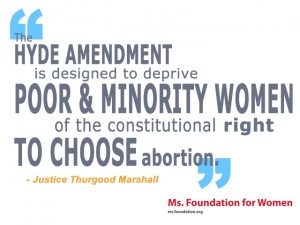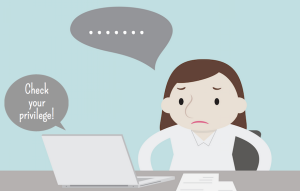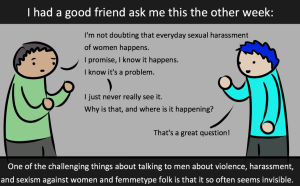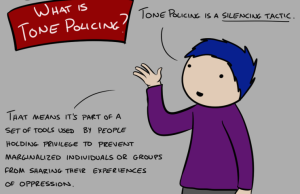
Credit: Ms. Foundation for Women
Imagine this – you’re poor and pregnant. Maybe you’re unemployed, having been laid off from your previous job and struggling to pay rent.
Maybe you already have three kids to take care of and you cannot afford a fourth.
Or maybe you’re still in high school, know nothing about raising a child and don’t know where to turn for help.
You know that you can’t afford this baby — you’ve weighed all possible options and the money just aren’t there. You’re barely making it as it as.
And so you decide that the only responsible option is to get an abortion. Given how much you make, it seems expensive, but you also know that it will be much cheaper than raising another child.
So you begin the planning process. You do some research to find out much an abortion costs in your state.
You currently receive federal and state Medicaid so you wonder if your health insurance will cover abortions as well. And then you learn that it’s prohibited, due to the Hyde Amendment, a regulation that restricts all federal funding for funding in Medicaid except in cases of rape and incest.
The Hyde Amendment is not a permanent law. It is a “rider” that, in various forms, has been routinely attached to annual appropriations bills since 1976 (just 3 years after Roe versus Wade). That means every year, it can get repealed. But due to the dominant “no public funding for abortions” mantra, every year it gets approved.
Having had no luck with the federal government, you check on your state Medicaid. If you’re fortunate enough to live in one of the fifteen states where abortion services are covered by Medicaid, then you may have just found the help you need — that is, if you meet the federal poverty guidelines and are eligible to receive assistance.
In the meantime, you’re trying to scrounge together funds—skimping on food, asking close friends for a loan, selling things.
And the procedure is not the only cost. You also need to find money to cover travel expenses, especially if you live in a state that has only one abortion provider and you live 200 miles away from it.
And if you don’t want to go alone and want someone there to support you (as many women do), you’ll have to just hope a family member or friend is able to afford the travel costs as well.
To make matters worse, while you’re busy worrying how it’s all going to work out , the timeframe in which you can legally obtain an abortion is closing, the cost of the abortion is rising, and the risk of complications is increasing.
So what now? What do you do if you’ve scrimped, saved and sold all your things but still can’t afford to have an abortion?
This is a question that 200,000 women in America face every year. Today, women who have an abortion are more likely to have incomes below the federal poverty line ($18,530 for a family of three). In 2008, 42% of women seeking an abortion had incomes below the federal poverty line.
If they’re lucky, they get referred to an organization like National Network of Abortion Funds (NNAF), which “works to make sure that all women and girls can get the abortions they seek.”
If they don’t know about NNAF and can’t find other means to obtain an abortion, these women — forced to raise a child they can’t provide for — too often end up sinking deeper into poverty.
It’s time we repeal the Hyde Amendment so there’s federal funding for Medicaid to cover abortion in order to ensure that low-income women have the ability to control their own lives and plan for their families just like women who have more well-off.
Unfortunately, this reality may not be well understood or known to the pro-choice people who don’t believe the government should intervene to ensure ALL women have access to abortion services if needed.
While they are, of course, free to have their opinion, let’s explore these objections in hopes of persuading them to join us in fighting for public funding for abortion services.
Some Objections Pro-Choice but Anti-Government Funding People Make
1. “I support the right to choose. I just don’t think the government should pay for it.”
But if we agree that reproductive rights are basic human rights, and we are granted those rights by the constitution, then shouldn’t the government intervene when our basic needs are not being met?
After all, the government provide funds for food assistance when we can’t afford food, disability checks to those who cannot physically work, and Medicaid to those who can’t pay for basic healthcare.
And in fact, studies show that 62% of people support allowing insurance companies to cover abortion in both publicly and privately funded health plans. That’s a stronger majority than most other bills that get passed get.
2. “I’m pro-choice but women who can’t afford to raise a child shouldn’t be having unprotected sex anyway. They need to deal with the consequences of their bad behavior.”
So, women who can’t afford to raise a child should never have sex and shouldn’t get raped (as if that was under their control)…Because that is actually the only way to ensure 100% that they won’t get pregnant, you know.
A couple problems with this line of thinking. First of all, contraception isn’t 100% foolproof, women who are raped sometimes get pregnant, some women are prevented from using condoms by their male partners, and low-income women without health insurance either cannot afford birth control or the cost is too high even if they have health insurance.
Second, this line of thinking implies that people who are poor should not be allowed to have sex and avoid being raped (impossible to do regardless). And if they do have sex and get pregnant, they just need to suck it up and accept their “punishment.”
So, in saying this, we’re not only placing judgment on these women and engaging in good ole’ fashioned slut-shaming, we’re also attempting to exert control over their private lives. How is that fair?
3. “It’s not my problem if she can’t pay for own abortion. Why should I as a taxpayer pay for it?”
Because as a taxpayer, you’ll end up paying to support her child anyway – from public schools, welfare, Medicaid, and in other forms of public assistance.
For women who can’t afford even the abortion procedure, how are they going to afford raising a child? Especially since 60% of women who seek abortion care are already mothers and more than three in 10 already have two or more children.
I’m sure they’ll do their best but given our economy, it can be very hard to move up the ladder when you’re busy working one or more low-wage jobs and raising children.
Legal access to abortion loses its meaning if a woman isn’t able to access it because of her income level. Approximately 1 in 4 women who would have had a Medicaid-funded procedure if funds had been available were unable to obtain an abortion.
That’s 1 in 4 women who didn’t have a choice.
So if you are pro-choice but against having the government cover abortions, please re-consider.
By denying federal and state funding of abortion, you’re essentially taking the right to choose away from low-income women.
Want to change this policy? Sign this petition here to repeal the Hyde Amendment and restore federal Medicaid coverage for abortion.
Then Medicaid would again cover abortion care like it does every other health care service a women needs.
Shannon Ridgway is a Contributing Writer to Everyday Feminism from the great flyover state of South Dakota (the one with the monument of presidential heads). In her free time, Shannon enjoys reading, writing, jamming out to ’80s music and Zumba, and she will go to great lengths to find the perfect enchilada. Follow her on Twitter @sridgway1980.
Search our 3000+ articles!
Read our articles about:
Our online racial justice training
Used by hundreds of universities, non-profits, and businesses.
Click to learn more
Most Read Articles
- « Previous
- 1
- …
- 30
- 31
- 32



















